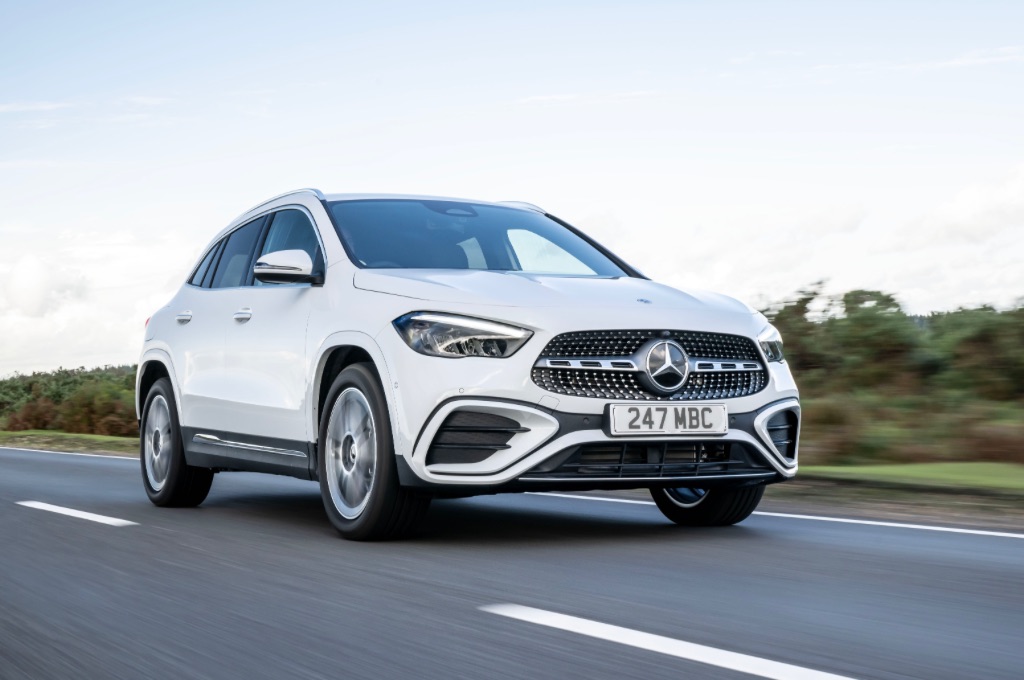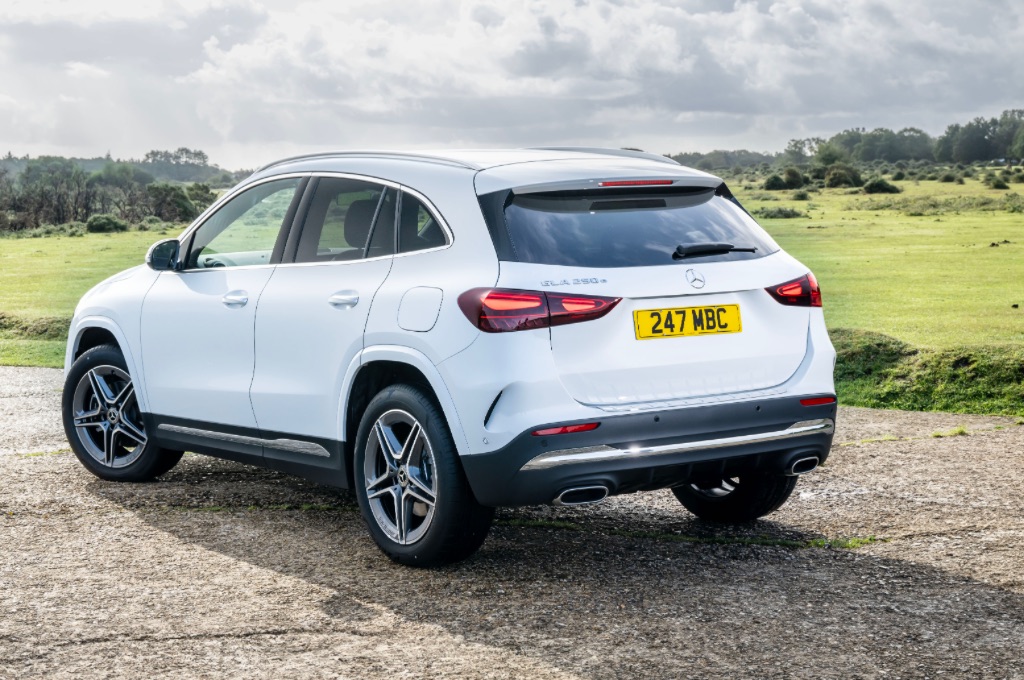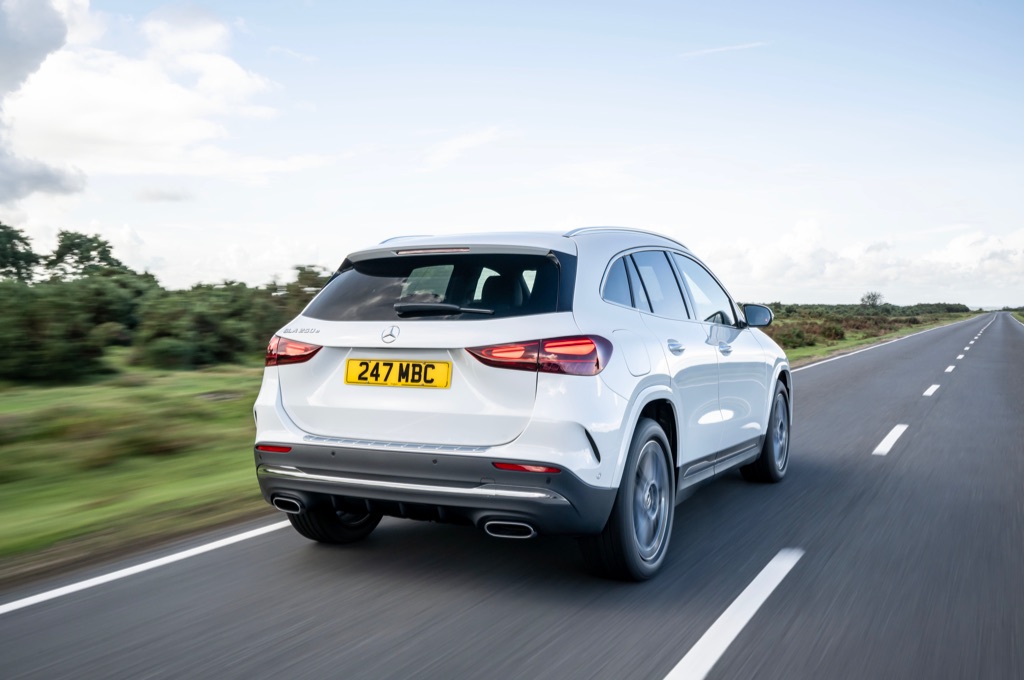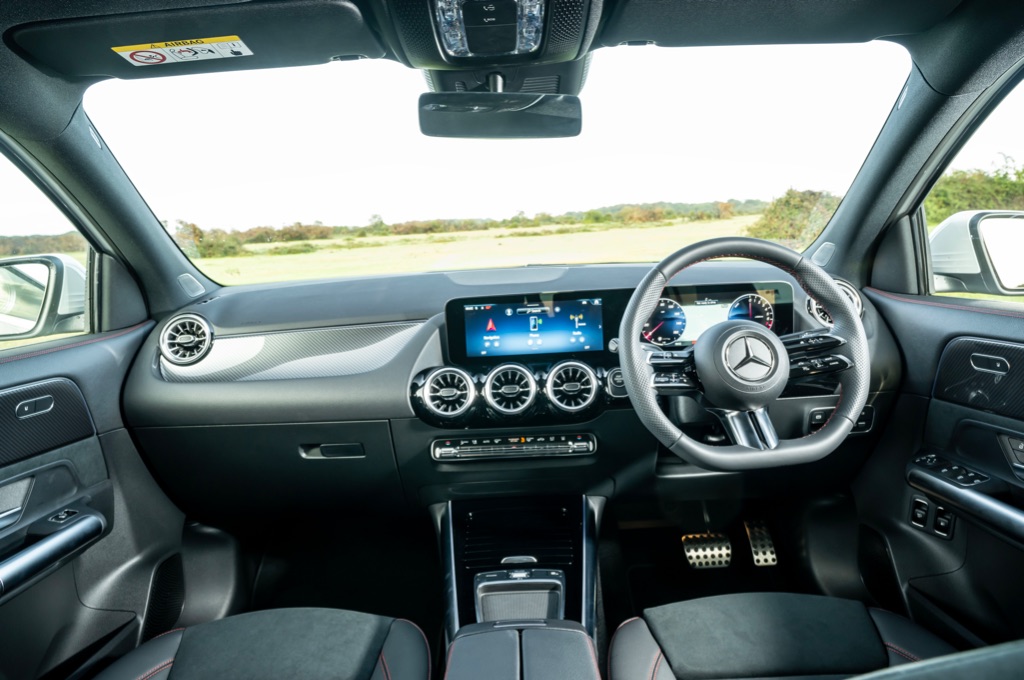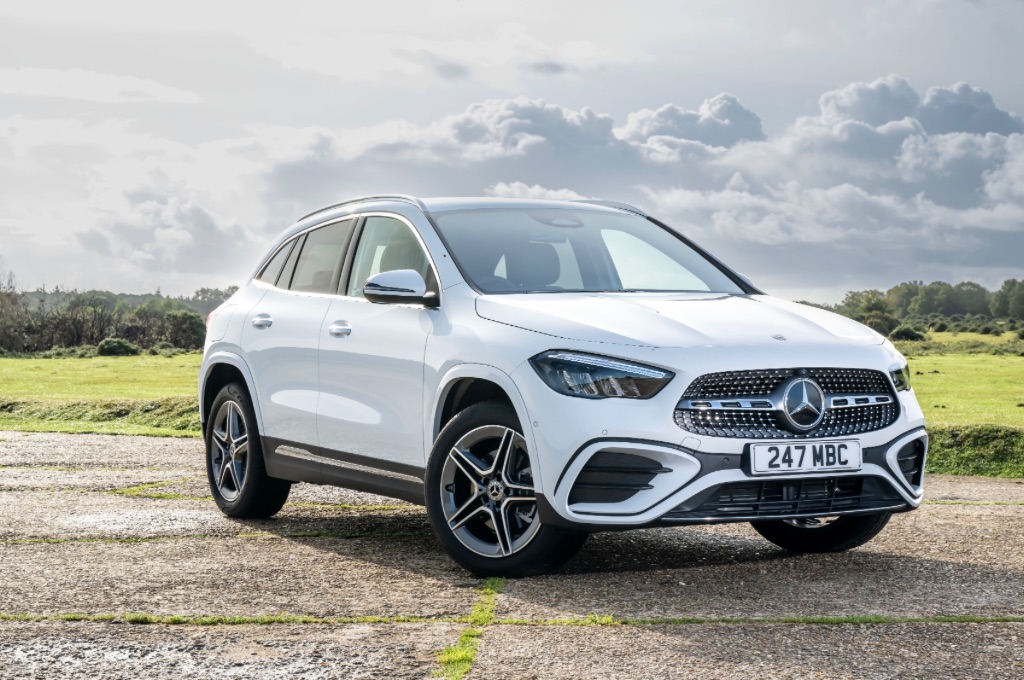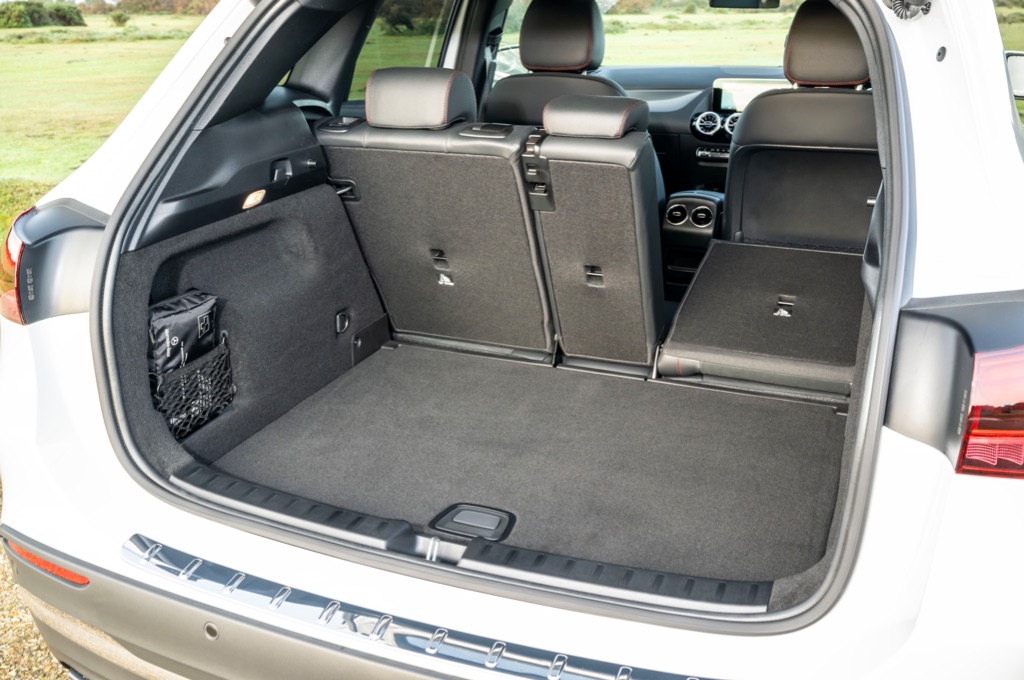At 4.4-metres long, the Mercedes GLA 250 e Plug-in hybrid Is a small-ish SUV; about the same size as its direct rivals, the BMW X1 and Audi Q3. Or, to put it another way, it’s actually a very similar size to a VW Golf and Mercedes A-Class, albeit raised up to give it the SUV stance and a bit more interior room.
That’s no coincidence, as the GLA is based on the same platform as the Mercedes A-Class hatchback.
Power in the GLA 250 e comes from a 1.3-litre, four-cylinder turbocharged petrol engine, while the electric motor is built into the eight-speed, dual-clutch automatic gearbox. Whether the car is running on pure electric power, petrol power or on both simultaneously, it’s always front-wheel drive.
Practicality and boot space
The interior is really smart in the Mercedes GLA, with the trademark Mercedes rotary vents always feature, supportive seats, and really dense-feeling, classy materials. Some of the plastics lower down the cabin are a bit scratchy and cheap, but generally it feels really smart in the Mercedes, and the general feel and ambience in the cabin is definitely a chief reason why you’d go for the GLA over its more affordable rivals. And there are lots of those, ranging from from the Kia Niro and Hyundai Kona through to the Volkswagen T-Roc and Peugeot 2008, while direct premium alternatives include the BMW X1 and Audi Q3.
The rear seats are reasonably spacious – you’ll be fine with a couple of car seats in those two pairs of Isofix fittings, and the higher roof makes it easy to bend in and wrestle with children and seatbelts. Mind you, there are much bigger family SUVs – the VW Tiguan, or (if you’re considering pure electric) Skoda Enyaq iV – are a similar price to the Mercedes and are usefully more spacious.
Still, the Merc is just as useful as those other posh, compact family SUVs that it competes with. The plug-in hybrid does lose a little space over its non-electrified stable mates, but 445-litres is still a really good size, and the boot floor is flush with the load lip so it’s easy to slide in a buggy.
It can also tow up to 1800kg, which is useful enough for a small caravan. For many motorists, the fact that you can have a towbar fitted to the GLA will be more useful as it means you can have a towbar-mounted bike rack that can carry multiple bikes.
Interior, design/styling and technology
The Mercedes GLA has most of the safety, luxury and infotainment tech that you’d expect, including wireless phone charging, keyless entry, cruise control, dual-zone climate control and more. A 10.25-inch driver’s readout and equally touchscreen are neatly displayed in the same housing behind the wheel and into the centra of the dashboard, and offer wireless Apple CarPlay and Android Auto, navigation, and all the media features you want.
You can also control the screen via the tiny touch-sensitive pads on the steering wheel, which sounds like a right faff, but once you’ve gotten used to it, it’s actually quite easy and we often prefer to use those than reach over and use the touchscreen when driving.
Overall, the Mercedes’ system is a touch complicated – especially at first. It takes time to get used to where all the sub-menus are to control settings like screen brightness, for instance. However, you can say much the same of most of the touchscreens in today’s cars, and in context of its rivals the Mercedes’ infotainment system and user interface is one of the best.
Battery, range and charging
The Mercedes GLA 250 e has a 16kWh lithium-ion battery that delivers an official claimed range of 43- to 48 miles, but the real world range will be more like 28 miles in winter, up to around 38 miles in slower driving when it’s warmer. That’s a bit better than the range you get in the Audi Q3 TFSI e and Cupra Formentor e-Hybrid, but the BMW X1 xDrive30 Plug In Hybrid goes usefully further – up to 56 miles to a charge, according to official figures.
You can also tell the Mercedes GLA whether you want it run in pure electric mode, and you can choose to save some battery charge for later in the journey. That’s a good function to have as it means you can rely on petol power on the motorway, when the little 1.3-litre engine will be at its most efficient, and then fall back on pure electric power around town, when the electric powertrain will be at its most efficient, as well as helping to keep emissions down in a congested area. Of course, there’s also a default hybrid mode, which the car will use to shuffle between electric and petrol running as it sees fit – it’ll even use information from the nav to decided when best to use petrol- or electric power, provided you’ve put the route into the car’s native sat-nav system.
Charging is up to 11kW on an AC charger, but you’ll need three-phase electric to benefit from those speeds, which you normally only find in industrial buildings. Still, lamp-post- and kerbside chargers that you often find in cities are routinely three-phase, and many can support 11kW charging, so if you charge using these urban public chargers, or if you have a charger at your workplace that can support it, you can charge the GLA from 10-100% in around 1hr and 45 minutes. You can fast charge via a DC rapid charging station at up to 22kW, which will get you an 80% charge in under 30 minutes.
Most owners will use a standard, single-phase 7.4kW home wallbox, which will do the same in under four hours, or if you plug into a normal three-pin domestic socket (you’ll need to buy the cable for this) then it’ll take more like eight hours.
Motors, performance and handling
The Mercedes GLA e 250 Plug in Hybrid is at its best when it’s in electric mode, whirring around smoothly on battery power. You can do motorway speeds quite easily without waking up the petrol engine, too, so it is easy to do the average run to the shops, or a local commute without using any petrol at all.
But when the petrol engine does start up, it sounds really gritty and you get noticeable vibration through the pedals, so it’s hard to ignore it when it does fire up. It also changes the throttle response as it goes from electric to petrol power, which feels a bit odd. Still, other than the moment it goes from pure electric to petrol-power, the GLA plug-in hybrid is easy enough to drive smoothly - even if it’s in hybrid mode with the petrol engine running. The 1.3-litre, four-cylinder engine quietens down when it’s warmed up, too, so overall the refinement isn’t too bad even if it’s not what you might expect of a posh Mercedes like this.
There are drive modes to toggle through, naturally, but the GLA is best in default Comfort mode when you can just mooch along and enjoy the light steering with its satisfying, oily build of weight that’s great for around town or a nice country road.
The moderately high-set driving position and decent visibility also encourage relaxing progress. Plus, if you do accelerate hard then the gearbox gets a bit clunky and the engine sounds noisy again – and not in a pleasant way. The 0-62mph of 7.9sec is hardly thrilling, either. All of which only goes to emphasise that the GLA really is all about pleasant, confident and relaxing progress, and that’s fine by us. If you do want a bit more fizz to your plug-in hybrid SUV’s handling and performance, the Cupra Formentor is the way to go.
Ride comfort on the GLA is fine; even on the 20-inch wheels of our AMG Line Premium Plus test car, it soaked up high-frequency bumps and coarse surfaces pretty well, but bigger bumps and undulations make it feel a bit lumpy. There are no adaptive dampers available, but stick to smaller wheels if you can as they’ll improve ride comfort as well as efficiency and electric range.
Running costs and pricing
The GLA Plug-in Hybrid isn’t available with the entry-level Sport Executive trim that you can get on other GLAs, so AMG Line Executive is the cheapest option. That gets parking sensors and rear-view camera, heated and electrically folding door mirrors, wireless phone charging, heated seats, the fancy dual-screen infotainment we’ve already talked about, 19-inch alloy wheels, keyless entry, leatherette upholstery with contrast stitching, carbonfibre-like trim inserts, and various AMG style features.
AMG Line Premium gets more interior options including light grey upholstery and trim inserts, and it also adds blind spot warning, an upgraded sound system and augmented reality navigation – which is where a live camera feed of the road is beamed onto the screen with an arrow superimposed over the top, to make it easier to see which turn you need to take.
The AMG Line Premium Plus adds a panoramic glass roof, fully adaptive LED headlights that maintain high beam illumination at night without dazzling oncoming traffic, electrically-adjustable front seats with memory function, and a 360-degree parking camera.
Pricing is hardly cheap, but it’s fairly competitive with key rivals like the BMW X1 and Audi Q3. The BMW starts from a lower price as you can get it with a bit less equipment, and the Mercedes finance agreements are typically a little pricier too – albeit these are very changeable with any manufacturer, depending on the deposit and terms of the deal.
Company car users will like the fact that the Mercedes’ recent facelift and rise in electric range has dropped it to Benefit in Kind (BiK) tax banding of 8%, making it one of the cheaper plug-in hybrid SUVs to go for as a company car.
Verdict
As a compact family SUV the GLA 250 e plug-in hybrid has a lot to offer. It is good to drive, has an electric range which is longer than most and a smart and comfortable interior which makes you think it's worth the money every time you climb inside. But it’s not as refined as you might hope, and rivals such as the BMW X1 PHEV go further on a charge. There are plenty of all-electric choices too which will make more sense to company car drivers looking for the lowest tax. The GLA is a fine car, but doesn't really excel in any area.
Like the Mercedes GLA PHEV? Try these...










